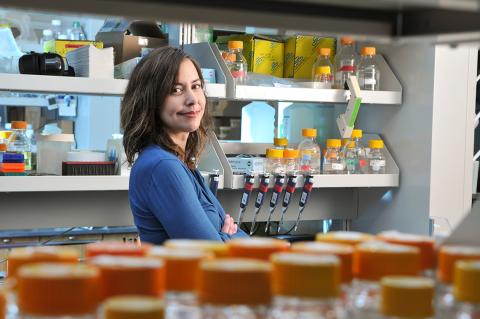Beer, Bread…Painkillers
Smolke Describes Use of Yeast to Make Medicine

Photo: ROD SEARCEY/STANFORD
Yeasts are simple, 1-celled fungi that people have used for fermentation and baking throughout history. Archaeologists combing through Egyptian ruins, for example, have found early grinding stones and baking chambers for yeasted bread, along with drawings of 4,000-year-old bakeries and breweries. In the 19th century, chemists and biologists such as Louis Pasteur began to study yeast and fermentation scientifically.
Today, Dr. Christina Smolke, an NCCIH grantee, has discovered a new use for humble yeast—reprogramming its biology so it can serve as a platform for producing medicines from natural products, including opioids for pain management and palliative care, which are in short supply in much of the world and pose many production challenges.
Her discoveries have brought her many accolades, including an NIH Director’s Pioneer Award, being named one of “Nature’s 10” (the 10 scientists who Nature determined mattered most in 2015) and her research being a runner-up for “Breakthrough of the Year” in Science.
Recently, Smolke lectured in Masur Auditorium as part of NCCIH’s Integrative Medicine Lecture Series, on “New Bio-based Supply Chains for Medicines.” She is associate professor, associate chair of education and W.M. Keck Foundation faculty scholar in the department of bioengineering at Stanford University and co-founder of Antheia, a biotechnology start-up company.
Currently, opioid drugs come from only one source, Smolke said—opium poppies. Among the production challenges: the medicinal part of the plant is very tiny, it can take a year to grow the plants and produce medicine, the land use is substantial and production is affected by many factors such as climate and variable crop yields. This, in turn, can drive up prices and decrease availability, especially for patients in developing countries.
Smolke and her colleagues demonstrated, in a proof-of-concept study published in Science in 2015, that they could genetically modify yeast to produce opioid compounds in just a few days. In efforts over about a decade, they eventually found the diverse building blocks they needed in freely available genomics resources, took more than 20 genes from 5 different organisms, engineered them and inserted them into the genome of baker’s yeast. In doing so, they created two different microbial assembly lines, each of which convert sugar into a medicinal compound: either thebaine (an opiate alkaloid) or hydrocodone (an opioid).
In her lecture, Smolke detailed some challenges the team faced and creative approaches they took to solve them.
“When we started 10 years ago, we thought this class of alkaloids was very interesting in terms of complex structure and the medicinal properties they can have; there had been very little work done on plant-alkaloid reconstruction in microbial systems. We thought a lot could be done there,” she said.
“People told me, ‘This is going to be impossible to do.’ But when people say that, it gets me thinking, ‘Okay, why is it impossible? What do we need to have happen to make it possible? If we want to do this kind of complex biosynthesis and make this level of molecules—what are the tools that need to be in place to be able to do this in a very efficient manner, so people can’t say it’s impossible and we just do it?’”
The Smolke team is now considered the first to produce synthetic hydrocodone using synthetic biology (which can be described as the re-design of existing natural biological systems for useful purposes). It’s a technique that holds many exciting possibilities as a platform, she said. It could eventually offer a more economically efficient route to drug production, reduce manufacturing time, improve access to medicines in impoverished nations and inform creation of scaffolds for developing other natural products, including treatments for disease.
A relatively “green” sustainable approach, it could also lessen the generation and use of hazardous substances associated with synthetic chemistry. Such bioengineering could also tweak medicines from natural sources to reduce undesirable side effects and, importantly for medicines like opioids, addiction potential.
Dr. John Williamson, chief of NCCIH’s extramural Basic and Mechanistic Research Branch, said, “Dr. Smolke’s research is, at this point in time, proof-of-concept and early stage work that illustrates the power of expression of complex plant materials in general. With further refinement, her team’s innovative process may ensure a stable supply of a critically important category of drugs and impact the development of bioengineering techniques to more efficiently produce other medicines crucial to public health, and at a more economical level. We at NCCIH are proud to have supported Dr. Smolke’s work and look forward to more innovations from her lab.”
Smolke’s lecture can be viewed at https://videocast.nih.gov/summary.asp?Live=18770&bhcp=1.
